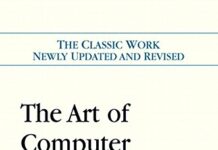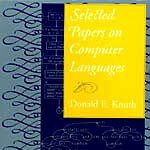
Ebook Info
- Published: 2014
- Number of pages: 912 pages
- Format: PDF
- File Size: 11.28 MB
- Authors: Donald E. Knuth
Description
The Art of Computer Programming, Volume 4A: Combinatorial Algorithms, Part 1 Knuth’s multivolume analysis of algorithms is widely recognized as the definitive description of classical computer science. The first three volumes of this work have long comprised a unique and invaluable resource in programming theory and practice. Scientists have marveled at the beauty and elegance of Knuth’s analysis, while practicing programmers have successfully applied his “cookbook” solutions to their day-to-day problems. The level of these first three volumes has remained so high, and they have displayed so wide and deep a familiarity with the art of computer programming, that a sufficient “review” of future volumes could almost be: “Knuth, Volume n has been published.” —Data Processing Digest Knuth, Volume n has been published, where n = 4A. In this long-awaited new volume, the old master turns his attention to some of his favorite topics in broadword computation and combinatorial generation (exhaustively listing fundamental combinatorial objects, such as permutations, partitions, and trees), as well as his more recent interests, such as binary decision diagrams. The hallmark qualities that distinguish his previous volumes are manifest here anew: detailed coverage of the basics, illustrated with well-chosen examples; occasional forays into more esoteric topics and problems at the frontiers of research; impeccable writing peppered with occasional bits of humor; extensive collections of exercises, all with solutions or helpful hints; a careful attention to history; implementations of many of the algorithms in his classic step-by-step form. There is an amazing amount of information on each page. Knuth has obviously thought long and hard about which topics and results are most central and important, and then, what are the most intuitive and succinct ways of presenting that material. Since the areas that he covers in this volume have exploded since he first envisioned writing about them, it is wonderful how he has managed to provide such thorough treatment in so few pages. —Frank Ruskey, Department of Computer Science, University of Victoria The book is Volume 4A, because Volume 4 has itself become a multivolume undertaking. Combinatorial searching is a rich and important topic, and Knuth has too much to say about it that is new, interesting, and useful to fit into a single volume, or two, or maybe even three. This book alone includes approximately 1500 exercises, with answers for self-study, plus hundreds of useful facts that cannot be found in any other publication. Volume 4A surely belongs beside the first three volumes of this classic work in every serious programmer’s library. Finally, after a wait of more than thirty-five years, the first part of Volume 4 is at last ready for publication. Check out the boxed set that brings together Volumes 1 – 4A in one elegant case, and offers the purchaser a $50 discount off the price of buying the four volumes individually. Ebook (PDF version) produced by Mathematical Sciences Publishers (MSP), http://msp.org The Art of Computer Programming, Volumes 1-4A Boxed Set, 3/e
User’s Reviews
Reviews from Amazon users which were colected at the time this book was published on the website:
⭐Question: Now that this is out, are all the items in the first 5 (part 4, 0-4) fascicles covered, or do I need them too?A careful reading and comparison of both shows that although most of the topics are covered in both, as this “IS” the final publication with corrections of the fascicles, the fascicles add important background as well as detail, whereas 4A is a MUST due to the incredible number of new problems and answers. As a compromise if you’re on a budget, you could get 4A for all combinatorials, or, for example, get fascicle 0 if you’re more into logic design, circuits, etc. rather than all combinatorics. Do NOT buy all 5 fascicles AND this book, or you’ll be double paying. However, the fascicles, in the older form, are available as .pdfs free. THIS BOOK updates and corrects all of them, and is complete.I can’t give all the contents for thousands of pages here, but if you go to Dr. Knuth’s website, there are uncorrected .pdf copies of the whole series, and an index of all past and future versions. Just Bing or Google the title with Volume 4A and choose the link that starts with cs dot utsa dot edu (Dr. Don’s site). The links come back here to Amazon for purchase, but give full uncorrected .pdfs to save you money on the previous fascicles as you compare them to this newer 2011 volume. That will also let you see in detail which, if any, of the previous fascicles you really want combined with 4A. Realize, though, that Dr. Knuth has corrected MANY sections in this 2011 combinatorial text, so even if you like the .pdfs of the previous sicles, you’ll clearly want 4A.In fact, when you go to that site, there is even a “volume 5/part B” uncorrected fascicle available as an advance .pdf. The Stanford site even has a few more. It gives valuable math background on the coming new part 2 volumes (4B, 4C etc.) of combinatorics (click on “pre fascicle 5A”), namely many of the discrete probability spaces not covered in any of the previous volumes, yet much more important today than ever before. Disclaimed as a probably error copy for expert circulation pre publication, still, I’d take Knuth’s errors over most expert’s correct info!!! A great read to bring the current 2011 volume, as well as the original combinatorics volume (v 1 fascicle 1, 2/2005; p. 144), up to date on stochastics not covered until 2013.With his usual humility, Knuth “apologizes” that he’s only now getting around to as important a topic as probability in the intro to 4B– basically apologizing for what NO ONE knew in the 60’s! He even asks if some of his earlier “not yet solved” problems might actually be solved with newer stochastic algorithms. He posts these updates both on his site and in the latest fascicles, so readers can stay up to date even on the cutting edge research. What a sweet man! Needless to say, you’ll love this volume along with the web content and augmenting fascicles.Knuth, who is 76 at this writing, also disclaims that 4B, C, D etc. are health dependent. God bless and long life Doc.UPDATE: Dr. Knuth emailed us with this update on both the fascicles and upcoming new features:”…I can imagine that somebody would like to buy justone of those five (…v4f0, v4f1, v4f2, v4f3, or v4f4), becauseof special interest in (or maybe teaching a class about) just onetopic. Also, the stuff on pages 48–75 of v4f4 — thehistorical survey of combinatorial generation — is the most”reader friendly” part of the whole book, it can be appreciatedby non-specialists of many flavors; so as a small paperback it ishandier than the full 900-page book, in spite of some warts.By the way, v1f1 is already out in eBook form, and we expect to have itjoined by Volumes 1, 2, 3, and 4A before October. We have taken specialpains to provide optimum cross-references (hyperlinks) within theseelectronic versions, and to make searches work well (although some of thecurrent reader-apps aren’t real fast when searching in a 900-page eBook).”
⭐Knuth has written many books considered classics. Some of the previous works have been set-up for where the real fun is – Combinatorics. In one of my own columns, I say “Never trust the brute-force power of a computer network to do the job of a combinatorialist.” In 1967, John P. Robinson and Arthur J. Bernstein published an optimal Golomb ruler with 24 marks (OGR24). Their solution was confirmed in 2004 by a massive distributed effort using tens of thousand of computer years.Knuth is attempting to discuss all the algorithms that will still be important 50 years from now. The amount of speed given using these algorithms is staggering.Some examples topics in the book:Page 222 – Algorithm S: Breadth-first synthesis of BDDsPage 293 – Balanced and Complementary Gray codes.Page 424 – Stirling numbers and set partitions.Page 449 – Generating binary treesHelpful mathematical illustrations feature prominently throughout the book, and pretty much every page is gorgeously formatted. Knuth developed TeX in part to produce beautiful books, and that is on display here.Many thoughtful questions are provided as an aid to learning these very useful techniques. The Answers section runs for 303 pages.It will take me months or years to digest most the information in this work, but I can’t imagine a better presentation for this difficult but lucratively useful material.
⭐Over 30 years, whew! I’m very pleased to be able to add this volume to the other three (I’ve had to replace volumes 1 and 3 because I wore out my first copies). And, I’m very glad I don’t have to complete a graduate course that would use this volume as a text, I’m not sure I’d have the stamina to make it though. Thank you, Dr. Knuth, for your guidance and challenges. They certainly made a significant difference in the success of my career. I’m sure that those of you who delve into this volume will be enlightened by it as well. I’m not qualified to technically critique or perhaps even understand a lot of the material in this book, but at least I’ll have the rest of my life to try. Now, doesn’t he still owe us one more?
⭐For anyone who has the first three volumes of “The Art of Computer Programming”, a review of the fourth is completely unnecessary. If you don’t yet own the first three, buy the whole set of four at a significant discount. More than half of the 900 pages is “Answers to Exercises”, whose coverage of the topic is encyclopedic. If you want to know what Dr. Knuth has been doing the last 30 years, here is the answer. What is amazing is that this volume, number 4A, is evidently a prelude for more to come.
⭐It is impossible to overstate the importance of Knuth’s “algorithms” series. Every programmer needs to have access to these and needs to know how to look up algorithms in them and implement those algorithms in your language of choice. (And do give credit to Knuth in your comments.) If you don’t, you are not a programmer and certainly not a software engineer, and you will be condemned to reinvent wheel after wheel after wheel until you learn better.
⭐Knuth. What more is there to say? Bought the first edition of Volume 1 back in 1970 and have dived sporadically into his work ever since, whenever I needed a better sort or randomization algorithm.Just having Knuth on my bookshelf makes me feel a whole lot smarter.
⭐Now I have a lot to digest in the 30 years since I read the original 3
⭐Love Don Knuth’s stuff! Hope he gets more volumes written! He’s great. Very happy!
⭐Written by Knuth, what else you need to know?
⭐Bought for mathematician/programmer husband who has the other volumes and has wanted this for years. He absolutely loves it and I can’t get any sense out of him now, cos he’s permanently got his nose stuck in it!
⭐Ho acquistato i primi tre volumi nella loro seconda edizione, e li ho “consumati” studiandoli per applicare ciascun trucco ai miei progrgammi. Attendevo con ansia l’uscita del quarto volume in quanto, finalmente, vi appare una doppia citazione del lavoro eseguito dal sottoscritto con alcuni colleghi sull’alfametica.Detto questo, confermo una volta di piu’ la concretezza e l’utilita’ di questa serie: Donald Knuth rimane un faro nell’ambito della Teoria dei Numeri e del calcolo automatico, ed il prodotto recensito non si discosta minimamente dall’altissimo standard presentato e mantenuto sui volumi precedenti.excellent for advanced mathematics
⭐OK
Keywords
Free Download The Art of Computer Programming, Volume 4A: Combinatorial Algorithms, Part 1 1st Edition in PDF format
The Art of Computer Programming, Volume 4A: Combinatorial Algorithms, Part 1 1st Edition PDF Free Download
Download The Art of Computer Programming, Volume 4A: Combinatorial Algorithms, Part 1 1st Edition 2014 PDF Free
The Art of Computer Programming, Volume 4A: Combinatorial Algorithms, Part 1 1st Edition 2014 PDF Free Download
Download The Art of Computer Programming, Volume 4A: Combinatorial Algorithms, Part 1 1st Edition PDF
Free Download Ebook The Art of Computer Programming, Volume 4A: Combinatorial Algorithms, Part 1 1st Edition



